Humans are one of the most cooperative and altruistic species on the planet. At the same time, humans have a long history of violent and deadly intergroup conflicts or wars. Recently, contemporary evolutionary theorists have revived Charles Darwin’s idea that human in-group altruism and out-group hostility might have co-evolved. Groups with more cooperatively aggressive men, they suggest, were more likely to prevail in the frequent lethal quarrels of human pre-history, and these men, therefore, were more likely to have passed on their genes. After a short introduction to evolutionary perspectives on war heroism, we describe selected characteristics of 988 modern war heroes, the US-American Medal of Honor recipients of WWI, WWII, the Korean and the Vietnam War, and discuss whether an evolutionary perspective can help us understand why these men risked their lives ‘beyond the call of duty’.
Dr. Hannes Rusch and Dr. Charlotte Störmer*
On June 19, 2014, President Barack Obama awarded the highest US-American military decoration, the Congressional Medal of Honor, to a young Marine, Lance Corporal Kyle Carpenter. Deployed to Afghanistan in 2010, Carpenter, aged 21 at that time, deliberately fell on a live hostile grenade to protect a fellow Marine, Lance Corporal Nick Eufrazio. Both marines suffered severe injuries from the explosion of the grenade, but both survived. With the Medal of Honor Carpenter’s action was officially recognized as an act of ‘conspicuous gallantry and intrepidity at the risk of his life above and beyond the call of duty’, as is the official wording in his Medal of Honor citation.
Heroism, i.e. deliberate perilous action to the benefit of others like that of Lance Corporal Carpenter, is an astonishing phenomenon that puzzles researchers of all disciplines.[1] Why would someone be willing to take such tremendous risks or even sacrifice his own life in order to protect others? Especially from the perspective of evolutionary biology it is challenging to find explanations for how such extremely altruistic, potentially self-destructive behavioral traits could be preserved over evolutionary time, as lethal heroic self-sacrifice obviously leads to the elimination of the respective individuals from our biological lineage. Nevertheless, as the many actions decorated with, e.g., the Medal of Honor or the Military Order of William show, such heroism exists; and one context in which it occurs particularly frequently is warfare. In the following two sections we outline the basic theoretical framework evolutionary theorists use in their effort to understand why war heroism exists. In the fourth section we draw on statistical data from our own research on Medal of Honor recipients to illustrate how selected military characteristics of US-American war heroes from 20th-century wars might correspond with these evolutionary explanations. Finally, in the fifth section, we critically discuss the limitations of our research approach and address a number of open research questions.
Evolutionary roots of warfare
Our species, homo sapiens, appeared on the evolutionary stage about 200,000 years ago. For most of the time since then, until becoming sedentary about 20,000 years ago, humans lived in comparably small, mobile forager bands comprising only a couple of dozens of individuals. A crucial premise of evolutionary perspectives on contemporary human psychology is that these last 20,000 years are a too short time period to allow for substantial changes in our genetic outfit. Therefore, evolutionary psychologists argue, we can expect our basic, deeply entrenched psychological mechanisms to be adapted to this ‘old world’ of our hunter-gatherer way of living and to the adaptive challenges we were exposed to during this time.[2] Whether war, i.e. violent intergroup aggression, is one of these adaptive challenges has been the subject of a long debate in 20th-century anthropology which continues to the present day.[3] While some scholars argue, in a Rousseauian spirit, that original human life was mostly peaceful and harmonic, others, taking a more Hobbesian perspective, hold that our ancestors were exposed to ‘continual fear and danger of violent death, and the life of man, solitary, poor, nasty, brutish, and short.’[4]
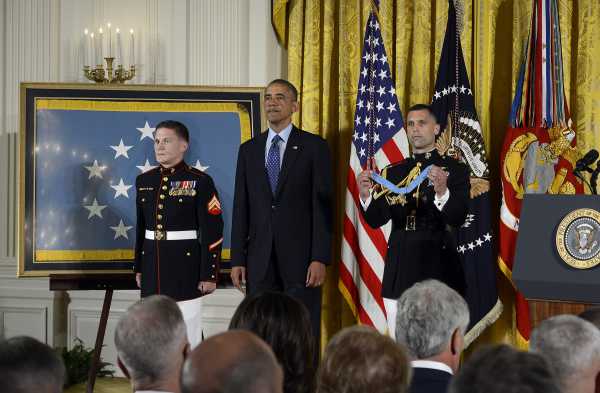
President Barack Obama and retired Marine Corps Corporal William ‘Kyle’ Carpenter, left, stand at attention during a Medal of Honor ceremony at the White House in Washington, D.C. June 19, 2014. Photo US Department of Defense, E.J. Hersom
Probably as a reaction to the horrific events of the two world wars, the Rousseauian perspective became dominant among anthropologists in the 1950s and 60s, who tried to explain that extreme scale of human violence against conspecifics as a result of misguided cultural developments, i.e. inhumane ideologies. This picture began to change, however, as more and more evidence was gathered by ethologists and anthropologists showing that deadly violence against conspecifics is neither an exclusively human phenomenon nor new in human evolutionary history. Today, most anthropologists agree that violent quarrels between human groups did accompany human prehistory continually and can be found in almost every human society that has been studied. The frequencies and intensities of these ancestral conflicts remain controversial topics, though.
While war undoubtedly is a domain in which humans deploy their most destructive and horrifying capabilities, it simultaneously is an arena for some of the most impressing displays of cooperation and altruism. Particularly from a biological perspective, it is astonishing to observe how readily men take extreme risks to achieve common goals in war. This coincidence of both extreme aggressiveness and extreme valor in human warfare raised the interest of evolutionary theorists very early. In a famous passage of his Descent of Man Charles Darwin himself wrote: ‘There can be no doubt that a tribe including many members who, from possessing in a high degree the spirit of patriotism, fidelity, obedience, courage, and sympathy, were always ready to give aid to each other and to sacrifice themselves for the common good, would be victorious over most other tribes; and this would be natural selection. At all times throughout the world tribes have supplanted other tribes; and as morality is one element in their success, the standard of morality and the number of well-endowed men will thus everywhere tend to rise and increase.’[5]
While the idea Darwin expresses here (later labelled ‘group selection’) seems plausible at first glance, it sparked a major debate which still divides evolutionary theorists today.[6] Put very shortly, one scholarly camp accepts the possibility that altruistic behaviors which benefit the in-group while being costly for the individual, like war heroism, can be selected for evolutionarily through selective extinction, or dissolution, of groups which possess fewer altruists than other groups. The other camp, in contrast, is skeptical that such a mechanism can actually be effective in nature. They argue that, in the face of realistic rates of migration between ancestral groups of humans, genetic differences between these groups were way too unstable and genetic variance within these groups way too large to allow for selective extinction of groups to have had a long-time effect on our genetic outfit. Rather, they argue, these behavioral traits must have induced, potentially quite indirect, benefits for the genes of the altruists. Particularly with respect to war heroism, the skeptics stress that two important sources of biological benefits for these altruists should not be ignored: reproduction and kin protection. In the following section, we will further develop these two perspectives.[7]
Biological benefits of war heroism?
It is, of course, provocative to ask how altruistic war heroism really is. Risking and even losing your life for the benefit of others is undoubtedly the most altruistic behavior which an individual human, or other animal, is capable of. However, what counts from the long-term evolutionary perspective is not the survival of one particular individual, but rather the proliferation of the genes this individual is carrying. Thus, if our aim is to understand how psychological traits fostering individually potentially self-destructive behavior, like war heroism, could have been selected for in human evolution, we must try to identify ways in which the genes responsible for the development of such traits might have spread.
Maybe the most direct way in which this might have happened is through group selection. Groups comprising many altruistic warriors might ‘simply’ have prevailed in the many violent intergroup conflicts of our evolutionary past. Taking a closer look at the groups our ancestors lived in, however, we find that these groups were often held together by close kinship ties, especially between the male group members. In a very simplified account, our forager ancestors frequently lived and fought in ‘bands of brothers’. From the perspective of evolutionary biology, then, it is much easier to understand why these warriors were ready to risk their lives for each other, as brothers share about half of their genes. Thus, if the self-sacrifice of one man could save the lives of two of his brothers, the genetic net balance would be zero which is of course much better than if all three brothers died. This is the basic idea behind the concept of ‘kin selection’ which might help us understand better how individually costly altruistic behaviors might have been promoted by natural selection.[8]
Kin selection, however, is not the end of the story. Protecting your relatives, and your spouse(s), from the threats of abduction and death posed by out-group aggressors is probably a strong motive of altruistic behavior when your group is under attack, i.e. in defences.[9] And indeed, analyzing the data on Medal of Honor recipients we will describe more detailed in the next section, a recent study found that, also in recent wars, there seems to be a tendency for directly altruistic forms of war heroism, like rescuing wounded comrades, to be observed more frequently when soldiers are on the defensive.[10] This leaves open the question, though, why war heroism also occurs during offenses (in fact, the majority, or about 60 percent, of the 988 Medals of Honor we have in our data set were awarded for heroic actions during attacks). Here again, a closer look at our ancestral way of living might help us to identify potential motives for war heroism during attacks. Acquiring valuable resources, like foraging territories, through aggression against out-groups improves the survival chances and living conditions of the in-group and, therefore, the logic of kin selection also applies to offenses, of course. However, an additional factor might play an important role here, namely sexual selection.
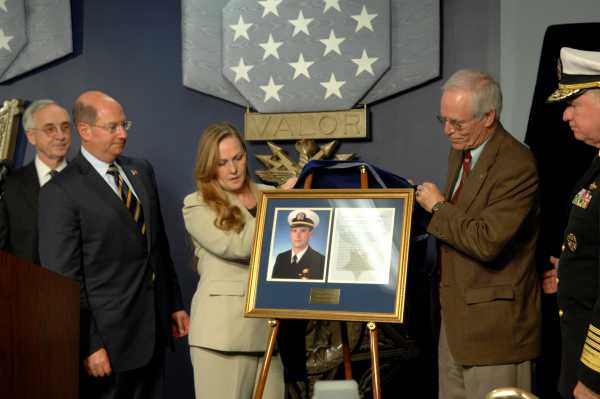
Daniel and Maureen Murphy, the parents of Navy SEAL Lt. Michael Murphy, unveil a photo of their son during a ceremony held at the Hall of Heroes inside the Pentagon. Murphy was posthumously awarded the Medal of Honor. He was killed during a reconnaissance mission near Asadabad, Afghanistan, while exposing himself to enemy fire in order to call in support after his four-man team came under attack by enemy forces June 28th, 2005. Photo US Navy, J. Pinsky
In humans, like in many other animals, the costs of reproduction vary significantly between the sexes. While, roughly speaking, the number of offspring men can have is only limited by the number of women they can attract, women have to be rather careful in deciding which man to choose as a father for their children. This is because, for women, each child means high costs in terms of the time and energy they have to invest into its rearing. This logic, in turn, induces a competition among men: they have to find ways of credibly proving their physical strengths and psychological skills to the women of their in-group in order to be chosen as a spouse. In solitarily living animals and in species where alpha-males gather harems of females, sexual selection can lead to deadly aggression between males, like in our closest animal relatives, the chimpanzees.[11] Under ancestral human conditions, however, this would have meant that brothers got into lethal conflicts over reproductive access frequently. One way of alleviating this problem is to divert the potential for aggression between in-group males to aggression against out-groups. These collective violent attacks against unrelated males from other groups, then, might have served as arenas for males to display their prowess to potential female mates of their in-group. War heroism, in this perspective, might then be understood as a reliable signal of outstanding individual capabilities meant to impress the opposite sex and also to intimidate male competitors in the own group.[12]
A number of anthropological and psychological studies have already established that, at least in some societies, heroic male warriorship is linked to increased reproductive success. In a famous classical study Napoleon Chagnon[13] found that in the Amazonian Yanomami battlewise warriors have more wives and more offspring.[14] But also in some contemporary societies soldiers have high standing with the opposite sex. A recent dating study in the US found that soldiers were highly favored dating partners.[15] To summarize briefly: Darwin’s idea that altruism towards the members of the own group and hostility against members of other groups might have been closely linked in human evolution can be stated more precisely. Given the conditions humans lived in for most of the evolutionarily relevant time, a readiness to take high risks during violent intergroup conflicts, particularly on the defending side, might have been promoted through kin selection because it benefited close relatives and increased their chances of survival. Adding to this, ‘gallantry beyond the call of duty’ might also have functioned as a reliable signal of individual prowess aimed at potential mates and male in-group competitors, thus increasing reproductive opportunities for heroic men.
Now, let us assume for a moment that this picture drawn by evolutionary theorists was more or less correct: what then could it lead us to expect about the characteristics of war heroes, maybe even under the conditions of modern warfare? A first, rather intuitive hypothesis to reach is, of course, that we should be able to identify meaningful differences between defensive and offensive heroic actions. Assuming that being under hostile attack triggers a deeply rooted psychological mechanism ultimately serving the protection of close kin, we can expect (1) to find more instances of heroic efforts to protect fellow soldiers in defences, and (2) that soldiers who have stronger psychological bonding with their comrades might also have a higher propensity to sacrifice themselves for their ‘brothers in arms’. For easier reference, we will label this the ‘kin-protection hypothesis’. A second, somewhat more remote hypothesis, derived from the potential importance of sexual selection and male status competition in this context, is that war heroism, particularly during offenses, might be systematically linked to the relative standing of a soldier within the hierarchy of his in-group. We will refer to this conjecture as the ‘status-competition hypothesis’.
Contemporary forms of war heroism
In order to be able to investigate empirically if traces of the potential evolutionary roots of war heroism outlined in the previous sections can still be found today, we have gathered a large data set on historical war heroes: the 988 recipients of the Congressional Medal of Honor, ‘MOH’ for short, of both World Wars, the Korean War and the Vietnam War. We collected all biographical data on these men available from online sources like ancestry.com, the National Archives (archives.gov), findagrave.com, and others. In addition, we systematically evaluated their official citations, formal documents describing the heroic actions which the medals were awarded for. When studying these documents, three rather distinct prototypical categories of heroic actions become apparent:[16] (1) rescue actions in which the respective MOH recipients saved, or attempted to save, the lives of comrades by non-violent means, i.e. not by engaging the enemy; (2) combat actions in which the respective MOH recipients showed outstanding bravery in direct combat with enemy forces; and (3) leadership accomplishments of MOH recipients who showed extraordinary tactical skills or exemplary conduct as superiors.
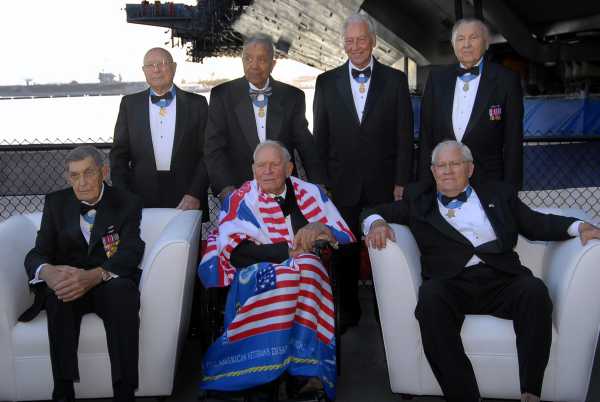
Medal of Honor recipients from World War II pose together before an awards ceremony held in the hangar bay aboard the USS Midway Museum. They received the Midway American Patriot Award and The National World War II Museum’s American Spirit Award during the black-tie gala ‘Beyond the Call of Duty’, 2008. Photo US Navy, J. Hudson
As our research on this data is far from completed and because we suppose this will be of most interest, we will focus here on presenting selected military characteristics of the heroes and their actions. After a short description of the data set, we present analyses of mortality and interesting differences between heroic actions during attacks and defenses. Thereafter, we take a closer look at one particular category of the war heroes, namely those 143 soldiers who, just like Cpl. Kyle Carpenter, were awarded the MOH for deliberately falling on live grenades or other explosive devices in order to protect comrades nearby.
Description of the data set
In total, 988 US-American soldiers received the MOH for heroic actions during the four wars we study. Of these, 119 men received the medal during WWI, 470 during WWII, 145 during the Korean War and 254 during the Vietnam War. The majority of recipients served in the Army (N = 638), followed by the Marine Corps (N = 189), the Navy (N = 101, including four members of the Naval Reserve and one Coast Guard member), and the Air Force (N = 60, including the Army Air Forces). Of the 988 heroic actions, we categorized 126 (13 percent) as instances of exemplary leadership, 272 (27 percent) as rescues and 590 (60 percent) as combat actions. In order to get an impression of the distribution of military ranks of the heroes we categorized them into three rank groups according to their pay grades: enlisted men (N = 256, pay grades E1-E3), non-commissioned officers (N = 405, pay grades E4-E9), and officers (N = 327, pay grades O1-O11; the eight warrant officers who received a MOH are also counted as officers).
Mortality
Figure 1 shows information on the mortality of the 988 MOH recipients broken down by wars and ranks. Mortality here refers to the question if the respective soldiers died as a direct consequence of their heroic actions, labeled ‘KIA’ for short. It is interesting to note that mortality not only differs between the ranks but also between the wars. WWI has the lowest mortality of MOH recipients (27 percent), followed by WWII (51 percent), increasing further in the Korean War (66 percent) and remaining roughly at that level in Vietnam (63 percent. With respect to rank we find that, overall, war heroes in the group of the enlisted men have the highest mortality (172 of 256, or 67 percent), followed by non-commissioned officers (216 of 405, 53 percent), and officers (139 of 327, 43 percent). Differences in mortality can also be observed between military branches. Overall, the Marine Corps has the highest mortality of MOH recipients (120 of 189, or 64 percent), followed by the Air Force (33 of 60, 55 percent), the Army (333 of 638, 52 percent), and finally the Navy (41 of 101, 41 percent).
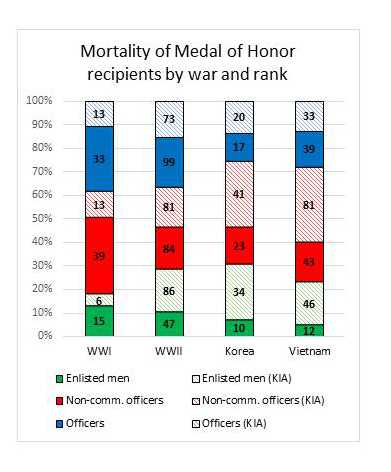
Figure 1 Absolute numbers and percentages of MOH recipients by war (columns) and ranks (colors); shaded parts indicate the number of recipients who died as a consequence of their heroic actions (marked ‘KIA’)
Differences between attacks and defenses
As we have argued above that, from an evolutionary perspective, the difference between attacks and defences is probably one of the most fundamental situational factors our evolved psychology reacts to. In order to test if this difference also affects modern forms of war heroism, we used the information available from the official citations of the MOH recipients to determine whether their heroic actions took place during attacks, i.e., when the strategic aim of their current missions was to capture specific locations or to destroy selected enemy targets, or during defences, i.e., when they were trying to hold their positions or retreating. Noteworthy differences between the two strategic situations can be observed. First, in line with our kin-protection hypothesis, a higher share of the heroic actions falls under the category of rescue actions during defences (42 percent) as compared to offences (18 percent). This, of course, is accompanied by a higher share of heroic combat actions during attacks (69 percent) as compared to defences (45 percent). The fraction of exemplary leadership accomplishments is the same in both situations (13 percent). When analyzing the distribution of the ranks of the MOH recipients, another quite noteworthy difference can be found: officers have a higher probability of having received a MOH during offences (69 percent) than during defences compared to non-commissioned officers (58 percent during offences) and enlisted men (53 percent during offences) for whom these probabilities are also biased towards offenses but significantly lower. In other words: higher status soldiers’, i.e. officers’, bravery seems more likely to be regarded as ‘heroic’ when displayed during offensives, which yields tentative support for our status-competition hypothesis.
Deliberate self-sacrifice
Let us now turn to a more detailed analysis of one particular kind of heroic action which can be regarded as one of the most extreme forms of altruism during warfare: deliberate self-sacrifice. Studying the official MOH citations, we identified 143 cases in which the respective soldiers used their own bodies as shields to protect comrades nearby from the impact of explosive devices, mostly hand grenades, but also other devices like Claymore mines or booby-traps. Only 19 (13 percent) of these soldiers survived. First, it is noteworthy that these acts of deliberate self-sacrifice have a significantly higher probability to have taken place during defences (53 percent) compared to the other forms of war heroism (only 38 percent of which took place during defences). Second, these acts were carried out mostly by enlisted men (43 percent) and non-commissioned officers (46 percent), which is a significantly greater share of lower ranked soldiers compared to the other heroic actions (23 percent of which were carried out by enlisted men and 40 percent by non-commissioned officers). Thus, at first glance, these findings yield additional support for both our hypotheses: for one, defences again seem to trigger a greater readiness to incur substantial risks to the benefit of comrades; for the other, higher hierarchical status, i.e. higher rank, seems to be linked with a higher propensity to act heroically in offenses. We suspect, however, that these two findings to some extent are explainable by the structure of modern warfare. First, hand grenades might be preferentially used as offensive weapons, which might explain why we observe this form of heroic self-sacrifice in defences more frequently. Adding to this, defenders trying to hold their positions are likely to be constrained in their movement which reduces the possibilities of evading incoming grenades. Second, owing to their military roles, officers are less likely to be involved in close combat with the enemy, which probably explains why this form of self-sacrifice is observed among lower ranking soldiers more frequently. So far, thus, there seem to be no decisive differences between the 143 soldiers who deliberately sacrificed their lives for their comrades by falling on live explosive devices and the other war heroes with respect to our two hypotheses.
When analyzing the age of the soldiers at the time of their heroic action, however, it becomes apparent that younger soldiers seem to have an increased propensity to self-sacrifice: looking only at the pay grades E3 and E4 (Privates First Class/Lance Corporals and Corporals), we find that the 86 MOH recipients in this group who deliberately self-sacrificed themselves had a mean age of 21.5 (± 0.25 s.e.) years, while the other 217 war heroes in this group of pay grades on average were 23.1 (± 0.29 s.e.) years old at the time of their heroic actions. This highly significant age difference between the two groups of heroes is reflected in a slight difference in the time spans which these groups of soldiers had served in the military before their heroic actions. Looking at pay grades E3 and E4 the self-sacrificing soldiers had spent about five months less in the service than the other heroes in these ranks. Sophisticated statistical analyses, however, indicate that the age effect on the propensity to self-sacrifice remains robust when controlling for time in service. We therefore suspect that a meaningful relationship between age and the readiness to self-sacrifice exists, i.e., we do not think that military inexperience is the main reason for the age difference we observe here.
Finally, another noteworthy observation regarding self-sacrifice is the following. Compared to the other forms of war heroism, deliberate self-sacrifice is observed more often in the U.S. Marine Corps, an elite service branch renowned for its tough drill and outstanding esprit de corps. While only 189 (19 percent) of all 988 MOHs in our data set were awarded to Marines, 60 (42 percent) of the 143 soldiers who deliberately self-sacrificed were members of the Marine Corps which is a highly significant overrepresentation of Marines in this group of heroes (see Figure 2 for a comparison of MOH awards for self-sacrifice and other actions between Marine Corps and the Army).
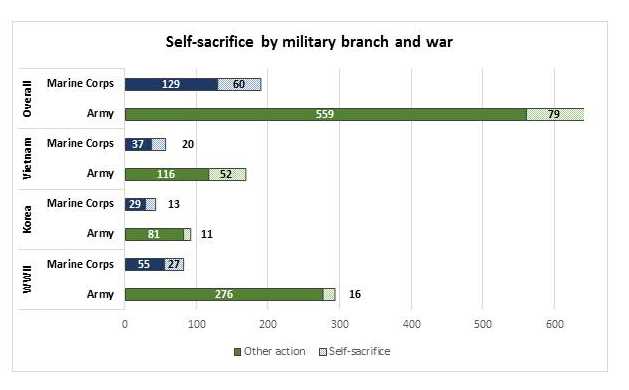
Figure 2 Number of MOH recipients serving in either Army or Marine Corps by war and in total; the shaded parts of the bars represent instances of self-sacrifice, solid parts represent all other actions
When viewed together, we think that these last two findings yield additional support for our kin-protection hypothesis. First, altruistic self-sacrifice seems to be displayed with higher probability by younger men who are more likely to possess a mindset tuned to the protection of their natal families, i.e. their parents and siblings, because they are less likely to have a family of their own, yet. Second, Marines are overrepresented in the group of self-sacrificing war heroes. We suppose that, in the light of our kin-protection hypothesis, this might be no coincidence, as Marines went through extremely tough recruit training together, which is likely to induce strong psychological bonds between them, resembling those between family members.[17]
Conclusion
What can we learn from the findings we have just presented regarding potential evolutionary explanations of war heroism? Let us return, for a moment, to the case of Lance Corporal Carpenter whom we got to know in the introduction. We now know that, while his heroic action is most certainly outstanding and praiseworthy, Lance Corporal Carpenter is not alone. In fact, LCpl Carpenter is quite representative of a group of 143 American soldiers who distinguished themselves through acts of utterly fearless self-sacrifice to protect their fellow soldiers. Many of these war heroes were Marines like Carpenter. Many of them displayed their bravery in a defensive position, just like he did. And, finally, many of them were almost exactly his age. What does this teach us? In his speech during Lance Corporal Carpenter’s award ceremony, President Obama told the story of Carpenter and the comrade he protected, LCpl Eufrazio. They had gone through recruit training together and, when deployed to Afghanistan, patrolled together. They shared ‘a friendship forged in fire’ as Obama put it. In the end, Obama even quoted Carpenter directly who had said that he loved his comrade Eufrazio ‘like a brother.’ From the evolutionary perspective we outlined in this article, and particularly in the light of our kin-protection hypothesis, these words make literal sense.
So far, nevertheless, our scientific understanding of the phenomenon of war heroism is very incomplete. Currently, we can only speculate that the intuitive mindset of young men fighting together in modern wars might reflect the conditions under which our ancestors fought their wars. In these, self-sacrifice was likely to benefit close kin and heroism likely to increase reproductive chances. It remains to be shown more conclusively by future research, however, that it is the same motivational complex that ultimately drives contemporary warriors. With our work on the biographies of Medal of Honor recipients, but also war heroes more generally, we would like to add to this line of research.
Open questions we are currently investigating include which other biographical and demographical characteristics of individual soldiers increase their probability of acting heroically and which positive consequences – e.g. with respect to social status and reproduction – but also which costs – e.g. with respect to post-traumatic stress – war heroism has in post-war life. Furthermore, we urgently need more detailed data on war heroes and their biographies from other times and cultural backgrounds to cross-test if our findings from American soldiers are generalizable. One particularly interesting question in this context is if – and if so, how – the outcome of a war, victory or defeat, affects the social standing of that war’s heroes. Moreover, we so far have not been able to research one additional, and potentially very important, motivation for war heroism, because we have exclusively focused on its consequences on in-group relations. Yet, extreme bravery also represents a reliable signal of strength to the enemy: this needs to be investigated more closely.
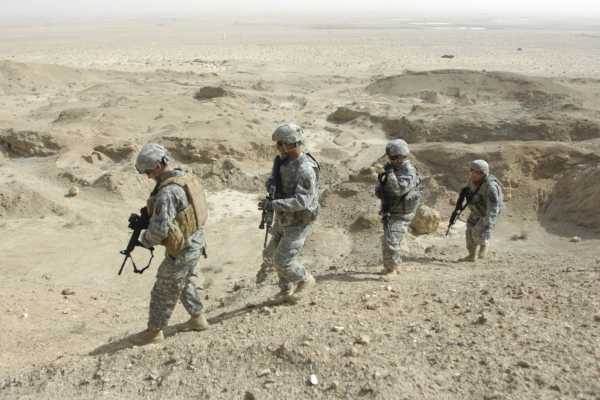
So far our scientific understanding of the phenomenon of war heroism is very incomplete and we can only speculate that the intuitive mindset of young men fighting together in modern wars might reflect the conditions under which our ancestors fought their wars. Photo US Army, S. Morris
We should not end without having clearly stated that the approach to researching the psychological foundations of war heroism we have presented here has at least two crucial limitations. First, like the results of any statistical approach, our findings are of correlational nature: they cannot uncover causal relationships. Second, many plausible alternative explanations for our findings exist, and we cannot rule them out conclusively using the data we currently have. A solution to both these problems is the systematic experimental study of the actual causal influence of those factors indicated as potentially important by our statistical archive studies. We are working on this. Finally, we would like to clarify that our research is not intended to deprecate the valor of individual war heroes in any way. While our research will hopefully help us to understand better why some men in certain situations display more courage than others, their deliberate decisions to risk their lives beyond the call of duty remain most formidable.
* Dr. Hannes Rusch is a researcher in Behavioral and Institutional Economics and in Philosophy of Biology at the Justus Liebig University in Gießen and a postdoctoral fellow at the department of Business Ethics at the TU Munich. Dr. Charlotte Störmer is a researcher at the Department of History and Art History, Utrecht University.
[1] For an overview of relevant literature see, e.g., Zeno E. Franco, Kathy Blau, and Philip G. Zimbardo, ‘Heroism: A conceptual analysis and differentiation between heroic action and altruism,’ in: Review of General Psychology 15 (2) 2011.
[2] See, e.g., John Tooby and Leda Cosmides, ‘Groups in Mind: The Coalitional Roots of War and Morality,’ in: Henrik Høgh-Olesen (ed.), Human Morality and Sociality. Evolutionary and Comparative Perspectives (Basingstoke, Palgrave Macmillan, 2010) 191-234, and Kevin N. Laland and Gillian R. Brown, Sense and Nonsense. Evolutionary Perspectives on Human Behavior (New York, Oxford University Press, 2011).
[3] For more detailed accounts of the current anthropological knowledge about (pre-)historic intergroup conflicts we refer interested readers to the excellent and comprehensive books by Azar Gat, War in Human Civilization (Oxford, Oxford University Press, 2008) and Lawrence H. Keeley, War before Civilization. The Myth of the Peaceful Savage (New York, Oxford University Press, 1996).
[4] Thomas Hobbes, Leviathan (Oxford, Clarendon Press, 1651/2012) Chapter XIII.
[5] Charles Darwin, The Descent of Man and Selection in Relation to Sex (London, John Murray, 1871) Chapter V.
[6] For a recent overview see, e.g., Egbert J. J. Leigh, ‘The group selection controversy,’in: Journal of Evolutionary Biology 23 (1), 2010.
[7] Much more detailed information about the status quo of this debate can be found, e.g., in Hannes Rusch, ‘The evolutionary interplay of intergroup conflict and altruism in humans: a review of parochial altruism theory and prospects for its extension,’ in: Proceedings of the Royal Society B: Biological Sciences 281 (1794) 2014.
[8] For more information on this central concept of evolutionary biology see, e.g., Andy Gardner and Stuart A. West, ‘Inclusive fitness: 50 years on,’ in: Philosophical Transactions of the Royal Society B 369 (1642) 2014.
[9] For a more detailed discussion see Hannes Rusch, ‘The Two Sides of Warfare: An Extended Model of Altruistic Behavior in Ancestral Human Intergroup Conflict,’ in: Human Nature 25 (3) 2014.
[10] Hannes Rusch, ‘Asymmetries in altruistic behavior during violent intergroup conflict,’ in: Evolutionary Psychology 11 (5) 2013.
[11] See, e.g., Christophe Boesch et al., ‘Intergroup conflicts among chimpanzees in Taï National Park: lethal violence and the female perspective,’ in: American Journal of Primatology 70 (6) 2008.
[12] For more information on the ‘male warrior hypothesis’ see, e.g., Mark van Vugt, David de Cremer and Dirk P. Janssen, ‘Gender Differences in Cooperation and Competition: The Male-Warrior Hypothesis,’ in: Psychological Science 18 (1), 2007, and Melissa M. McDonald, Carlos D. Navarrete and Mark van Vugt, ‘Evolution and the psychology of intergroup conflict: the male warrior hypothesis,’ in: Philosophical Transactions of the Royal Society B 367 (1589) 2012.
[13] Napoleon A. Chagnon, ‘Life Histories, Blood Revenge, and Warfare in a Tribal Population,’ in: Science 239 (4843) 1988.
[14] Also see: Michelle Escasa, Peter B. Gray and John Q. Patton, ‘Male traits associated with attractiveness in Conambo, Ecuador,’ in: Evolution and Human Behavior 31 (3) 2010; Christopher von Rueden, Michael Gurven and Hillard Kaplan, ‘Why do men seek status? Fitness payoffs to dominance and prestige,’ in: Proceedings of the Royal Society B – Biological Sciences 278 (1715) 2011; Luke Glowacki and Richard Wrangham, ‘Warfare and reproductive success in a tribal population,’ in: Proceedings of the National Academy of Sciences 112 (2) 2015.
[15] Günter J. Hitsch, Ali Hortaçsu and Dan Ariely, ‘What makes you click? Mate preferences in online dating,’ in: Quantitative Marketing and Economics 8 (4) 2010.
[16] For methodological details see Hannes Rusch, ‘Asymmetries in altruistic behavior during violent intergroup conflict,’ in: Evolutionary Psychology 11 (5) 2013; for complementary analyses see also Joseph A. Blake and Suellen Butler, ‘The Medal of Honor. Combat Orientations and Latent Role Structure in the United States Military,’ in: The Sociological Quarterly 17 (4) 1976; Joseph A. Blake, ‘Death by Hand Grenade: Altruistic Suicide in Combat,’ in: Suicide and Life-Threatening Behavior 8 (1) 1978; Jeffrey W. Riemer, ‘Durkheim’s ‘Heroic Suicide’ in Military Combat,’in: Armed Forces & Society 25 (1) 1998.
[17] For a recent study on this phenomenon see Harvey Whitehouse et al., ‘Brothers in arms: Libyan revolutionaries bond like family,’ in: Proceedings of the National Academy of Sciences 111 (50) 2014.